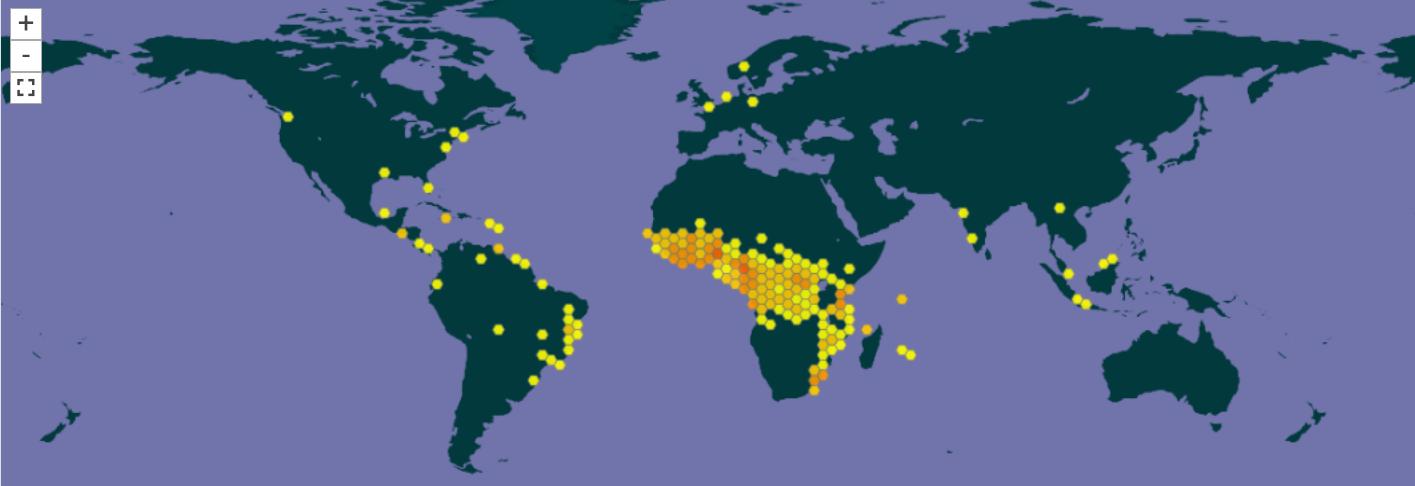
Originally, the cola nut and its many subspecies are found in almost all countries of West and Central Africa, where the favorable tropical conditions for them prevail. Cola nitida (the economically most important subspecies) is native to Ghana, Sierra Leone, Ivory Coast, Nigeria, and Liberia. Today, cola is also found on the Asian and American continents and has already been cultivated in Angola, Brazil, Chad, Congo, Democratic Republic of Congo, Equatorial Guinea, Ethiopia, Gabon, Guinea, India, Jamaica, Kenya, Mali, Mozambique, Senegal, Somalia, Sudan, Tanzania, Togo, Uganda, USA, and Zimbabwe.
A comprehensive and active database with a world map regarding the approximately 140 cola species is provided by GBIF. The diversity in growth, color, and forms is fascinating, as shown in their gallery, but this is not the focus of this website.
Climate
The cola nut requires a (sub)tropical climate with average temperatures of 23°C – 35°C and grows in the lowlands up to a maximum height of 300m. It prefers an annual rainfall of 1200mm to 1800mm but is also capable of enduring longer dry periods without problems, as is climatically typical in its West African homeland. It grows on both sandy and clayey soils and occasionally in swampier areas as well. Normally, however, it prefers well-drained soil. Interestingly, the cola tree develops a significantly wider crown and bears more fruits when it can stand freely, even though it is a lowland forest tree and naturally grows there.
Distribution
Modern distribution of the cola nut in Africa Several factors contributed to its distribution. On the one hand, the energizing and healing properties of the cola nut have been highly valued by the local population. This led to the cola nut spreading along with the movement of African settlers and being found wherever there were larger and smaller population centers. This happened through both agricultural use and the flourishing trade that spread over land and sea routes. White Europeans who came to Africa with the beginning of colonialism also learned to appreciate the local animals and plants and valued the cola nut for its caffeine content. It gained additional fame through its use in the original recipe of the now world-famous Coca-Cola. Even though the taste and caffeine in this drink today naturally come from other sources, there are still soft drink manufacturers who use the cola nut as an essential ingredient in their cola drinks.
Furthermore, the cola nut is well suited as a pioneer plant for establishing new biotopes. It is capable of reproducing through self-fertilization (for a limited number of generations), so theoretically, even a single plant can establish a population if other conditions are favorable. Additionally, it is relatively undemanding and begins to form seeds after about five to eight years. Moreover, its seeds are very well adapted to withstand adverse conditions. Cola seeds also exhibit a wide variance in germination, which means that not all seeds germinate at the same time, increasing the likelihood that at least some of the seeds will 'miss' unfavorable weather, the season of other plants, or animals. Finally, the seeds of the cola tree remain viable for a long time. While other plants quickly germinate and consume all the nutrient reserves of their seeds to gain an advantage over competitors, cola can rely on its seed for a long time and is thus somewhat less dependent on regular rainfall and good soil quality until it has developed deeper roots.

Cultivation
The cultivation of cola (Cola nitida) does not take place exclusively in the form of agricultural cultivation as we know it in Europe, but also in agroforestry systems or permacultures in the forest. Ownership of trees and land is regulated, but agriculturally unused trees and plants grow among the trees that are harvested, as would be the case in a forest. All cultivation methods naturally bring their own advantages and challenges.
Cultivation on Plantations
For commercial use, cola is often cultivated in plantations as a monoculture, which short-term increases yields. This method enables efficient management, maximum control over growth conditions, and facilitates the use of conventional methods for fertilization and pest control. However, monoculture can bring long-term disadvantages such as soil depletion and increased susceptibility to pests and diseases, which in turn leads to an increased need for pesticides and fertilizers.
Agroforestry Systems and Permaculture
Traditionally, cola is part of a mixed culture, a natural ecosystem, which is significant for organic farming. In agroforestry systems, cocoa and cola can be cultivated together. Here, cola provides shade for the sensitive cocoa plants and contributes to soil improvement. The leaves and organic residues of both plants can be used as mulch to close the nutrient cycle and maintain soil fertility. During the harvest of cola and cocoa, the fruit shells remain directly at the tree, which further promotes the nutrient content of the soil. Additionally, cola and cocoa can be harvested in different seasons, which leads to year-round employment for farmers and thus they are not financially entirely dependent on the success of one crop.
The joint cultivation can promote natural enemies of pests, such as ants, which eliminates the need for pesticides. This method offers farmers the opportunity to diversify their income sources and thus become economically more stable. By integrating cola into cocoa plantations and permaculture systems, farmers can develop sustainable and productive cultivation methods that are both ecologically and economically advantageous. These approaches promote biodiversity, improve soil health, and contribute to sustainable agriculture.
Further reading: A map of confirmed occurrences of the Cola species provided by the GBIF Link

 DE
DE  EN
EN 